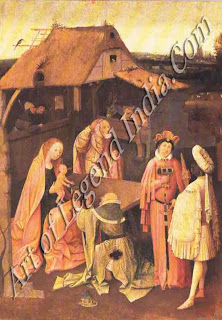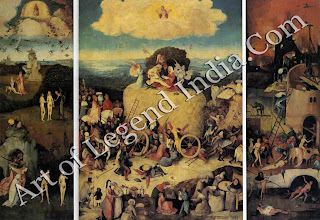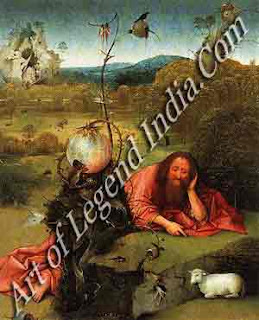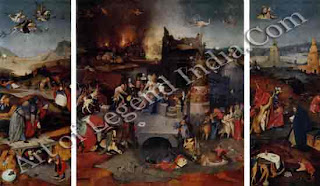 This
painting is generally accepted as one of Bosch's earliest designs; although
some scholars think it is a copy of a lost original rather than a work from the
master's own hand. It is a vivid depiction of gullibility and stupidity; the
bending figure whose dress indicates that he is some kind of dignitary is so
immersed in the tricks being performed that he does not notice his purse is
being stolen.
This
painting is generally accepted as one of Bosch's earliest designs; although
some scholars think it is a copy of a lost original rather than a work from the
master's own hand. It is a vivid depiction of gullibility and stupidity; the
bending figure whose dress indicates that he is some kind of dignitary is so
immersed in the tricks being performed that he does not notice his purse is
being stolen. Netherlandish Great Artist - Hieronymus Bosch Painting Gallery
Posted by
Art Of Legend India [dot] Com
On
4:21 AM
None of
Bosch's surviving paintings, of which there are about 40, bears a date or can
be dated by documentary evidence. This makes it extremely difficult to
establish a convincing chronology for his work. There is a fair measure of
agreement as to which paintings can be placed at the very beginning of his
career and which are from the flower of his maturity, but there are
considerable differences in scholarly opinion about the dating of individual
works and their place in his development.
The
Conjurer and Ecce Homo are generally thought to be among his earliest works,
their immaturity showing in the comparative stiffness and awkwardness of the
figures. Even in these paintings, however, there is a pointer to Bosch's later
preoccupations in the grotesque faces that reveal mankind's cruelty and folly.
The works on which Bosch's reputation now mainly rests are the three
astonishing triptychs, The Hay Wain, The Garden of Earthly Delights and The
Temptation of St Anthony. They swarm with bizarre figures and show Bosch's
imagination to have been one of the most powerful, original and disturbing in
the history of art.
As well
as creating such vast, teeming panoramas, Bosch could also focus memorably on a
single figure, as in St John the Baptist in the Wilderness, and he was a master
of the dramatic close-up, exemplified in The Crowning with Thorns. This last
painting is an excellent example of the beauty of Bosch's technique; it was not
tight and highly detailed, like that of many of his contemporaries, but subtle and
varied, the paint often applied very thinly.
 This
painting is generally accepted as one of Bosch's earliest designs; although
some scholars think it is a copy of a lost original rather than a work from the
master's own hand. It is a vivid depiction of gullibility and stupidity; the
bending figure whose dress indicates that he is some kind of dignitary is so
immersed in the tricks being performed that he does not notice his purse is
being stolen.
This
painting is generally accepted as one of Bosch's earliest designs; although
some scholars think it is a copy of a lost original rather than a work from the
master's own hand. It is a vivid depiction of gullibility and stupidity; the
bending figure whose dress indicates that he is some kind of dignitary is so
immersed in the tricks being performed that he does not notice his purse is
being stolen.
In
contrast to the violence of Ecce Homo, the atmosphere of this scene is one of
touching domesticity. Joseph doffs his hood and looks abashed at the presence
of such distinguished visitors. On the white sleeve of the king on the right is a depiction of the
Israelites gathering manna an Old
Testament allusion to the coming of Christ.
Pilate
presents Christ to the people of Jerusalem. Beside Pilate are the words 'Ecce
Homo' (Behold the Man); the crowd bays back 'Crucifige Eum' (Crucify Him) and
across the stone wall (where two donor figures have been painted out) is
inscribed 'Salve nos Christe redemptor' (Save us, Christ redeemer). Bosch
hardly needs words, however, to convey the horror mob law.
This is
regarded as the first painting in which Bosch revealed his unique imaginative
gifts. It is based on a Flemish proverb: 'The world is a haystack, and everyone
snatches what he can from it.' The hay wagon represents earthly goods, and the
whole world including a pope and an emperor goes with it as it rolls -
inexorably towards Hell on the right wing. Christ appears in judgment overhead.
In the left wing is represented the Garden of Eden, with the creation of Adam
and Eve and their expulsion from Paradise. There are many brilliantly depicted
details, notably the nuns in the foreground who stuff a sack with the precious
hay, and the lovers on top of the wagon who ignore the guardian angel behind
Ahem while a demon pipes in front of them.
This is
Bosch's largest, most complex and probably most famous painting; in it he
reached the height of his imaginative powers. It is similar in conception to
The Hay Wain, with Paradise and Hell in the wings flanking a central panel
representing mankind's sinful activities. Although the monsters are the most
hideous Bosch ever created, the painting has extraordinary beauty of colour.
There is another version of this painting, probably from Bosch's workshop, in
the Escorial near Madrid.
St John
lived an ascetic life in the desert. Bosch shows him pointing at a lamb, which
represents Christ the Lamb of God. The huge and fantastically-formed plant
beside which the saint reclines is probably intended to symbolize sensual
delights, which John has rejected for his life of religious devotion.
Somewhat
uncharacteristically, Bosch does not dwell on the physical horrors of the
scene, but instead creates a poignant image of suffering patiently endured the
beautiful head of Christ is one of the finest things he ever painted. The
significance of the bizarre headgear of the tormentors is uncertain.
St
Anthony was a hermit saint who lived in the 3rd and 4th centuries and is
generally regarded as the founder of monasticism. His ascetic life in the
wilderness brought on hallucinations, which featured prominently in the stories
about him that acquired wide popularity in the middle Ages. He became a popular
subject in art, too, and there are several copies of the whole or parts of this
painting. Bosch seems to have taken certain details from an account of the
Saint's life that was published in Dutch in 1490. St Anthony's `temptations' was
of two kinds: fleshly inducements in the form of sexual favours and worldly
goods; and attacks by demons (the Latin word 'tempto' has both meanings). Bosch
combined both meanings over the three panels, creating a dazzling and
disturbing fantasy world,
Writer
– Marshall Cavendish
Subscribe to:
Post Comments (Atom)


















0 Response to "Netherlandish Great Artist - Hieronymus Bosch Painting Gallery"
Post a Comment